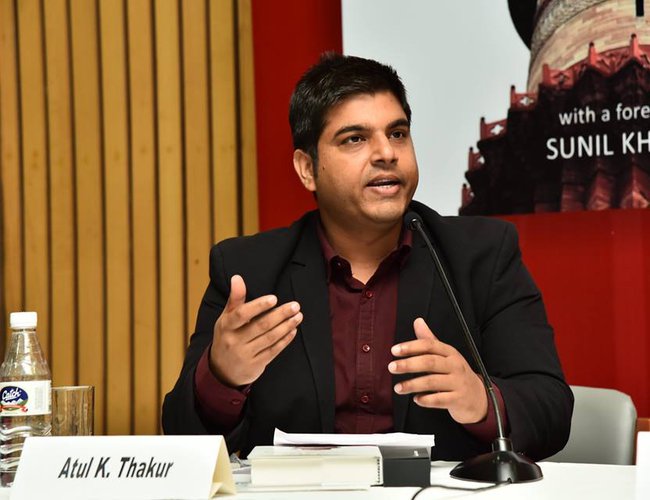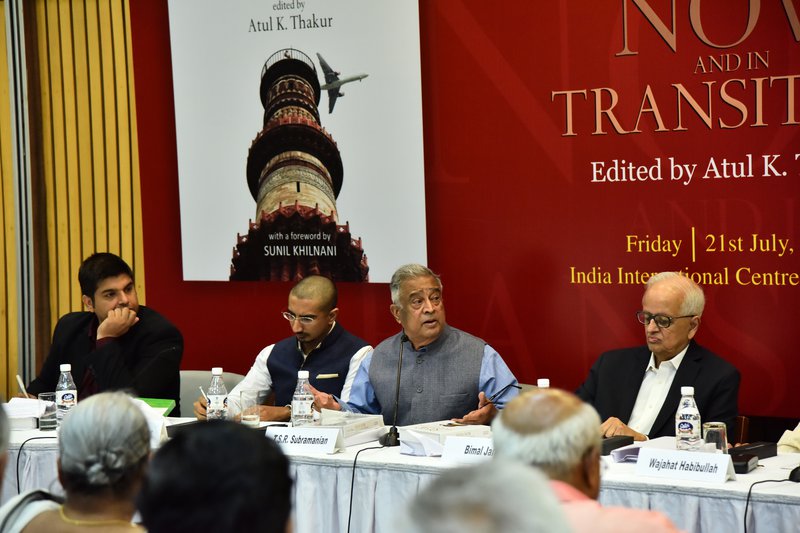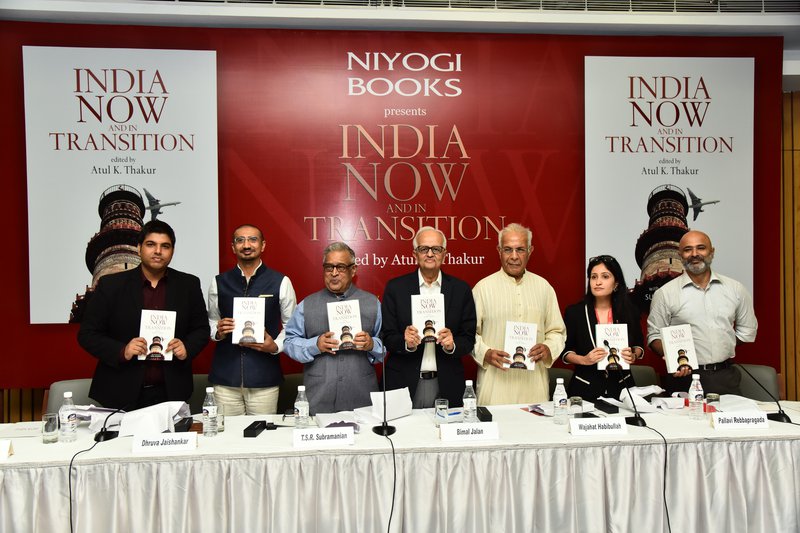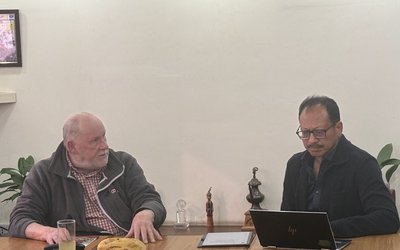
ATUL K THAKUR is a Views Columnist and Writer who specialises in the interface of politics and economics. His research and writing interests extend to macroeconomic policies and international affairs, with special focus on South Asia. He is an alumnus, inter alia, of Banaras Hindu University and has worked across sectors, spanning policy research, management consultancy, publishing and media.
India Now and in Transition is his second book as an editor. He has previously edited India since 1947: Looking Back at a Modern Nation (Niyogi Books, 2013), a significant work on modern India. He is currently working on the book project that deal with Nepal’s complex political-economic transitions and ethnicity issues and another on India’s journey with economic reforms.
He has been a columnist for some of the leading publications in South Asia and has written extensively for them, including DailyO and The Kathmandu Post. He is also a literary critic, having reviewed hundreds of books for leading publications in India and abroad. Recently, he talked about his new book and state of affairs in India. Here is an edited excerpt of interview:
What prompted you to do this sequel to your previous book - India’s 70 years of democracy, or the surprising victory of the BJP in 2014? Was the latter, anyway, a critical moment for India?
Honestly, this was the first idea that confirmed my inner call to attempt to bring out a comprehensive collection of essays, written without any preoccupation or enter into the prognosis. As the centrality of thought rested with ‘India’, I naturally had to count on its brightest tribute, democracy – and inspire myself and fellow writers to delve with the complex subjects with which India was concerned then and will be in transition.
As an editor, I work on something to make it compatible with the readers' expectations. As a writer, first, I answer my own queries. Normally, I read a lot – not to write anything particular but to stay in the mental state where I can silently cope with the chaos of ideas.
The beauty of India is that there are many kinds of Indias. Understanding the fundamentals that have given birth to such multiplicity across various segments is especially imperative in the present day, when the ‘Idea of India’ is keenly contested.
India Now and in Transition is thus an enquiry into possible futures, based on current happenings.
In confession, I thought to work on a book after reading full-time for one-and-half decade – and writing extensively on opinion/edit pages of broadsheets. Being a compulsive reader, it was somehow natural to tempt and turn as a columnist and writer – to find a way of expressions.

How India Now and in Transition looks on India?
India Now and in Transition offers fresh insights into several crucial areas, elements that have shaped India into what it is today, whether that be the complex set of relations under the country’s federal system, the challenges of territorial/cultural diversities, and the contradictory outcomes of economic reforms, among others. This book looks diligently at the successes and failures of India’s tryst with democracy, which—despite having many flaws—is charting its course ahead.
India is the world’s largest democracy with nearly 70 years of independent existence. Its unique and ever-changing nature has sparked a great degree of academic debate, both before and since Independence. The beauty of India is that there are many kinds of Indias. Understanding the fundamentals that have given birth to such multiplicity across various segments is especially imperative in the present day, when the ‘Idea of India’ is keenly contested. Our nation has the world’s largest youth population and is undergoing tectonic social and political changes at present, therefore, understanding what directions India may take in the future is essential for every thinking individual.
India Now and in Transition is an enquiry into possible futures, based on current happenings. Featuring contributions from leading thinkers and scholars in diverse fields, each essay in this volume critically analyses a major theme of India's present, to propose the likely way ahead for our emergent nation. Covering the fields of politics and governance, economics and development, security and foreign policy, society and culture, and language and literature, the book shows that—while beset with both internal and external challenges on many fronts—India isn't waiting for its moment, it's making its moment happen.
When you’re talking about India’s future, how many years from now are you looking at?
On this, it would be hard to go through the figures. My first edited work, India Since 1947: Looking Back at a Modern Nation(2013) was a collection of essays on a nation that was still trying to come into its own. If we consider the state of our nation today, in certain aspects India has come a long way, while in many others it has a challenging journey and many tough transitions ahead.
This sequel, India Now and in Transition, is based on how ‘India’ is being shaped through contemporary political events and other key determinants. What this book intends is not a prognosis (which is often confused with prediction), but, rather, an inquiry into futures based on current happenings. This necessarily entails deconstructions of the past, as in the previous volume. A causal linearity is maintained, so that the futures proposed will be the likeliest. To that end, the exegesis is rigorously researched, referenced and argued. The book is not intended to be a mere warehouse of opinions. Together, the two volumes cover India's continuum from a nascent nation-state to a mature one.
How dominant the role of a governing party’s ideology is in shaping India’s future?
A: Since 1947, India as a nation has made significant strides. However, those were not enough. The realisation is growing stronger, as democracy is deepening every day. Despite having followed a ‘reluctant revivalist’ tendency for close to seven decades, now, in an increasingly technocratic situation, the overall ‘governance discourse’ is gaining ground to charter something as desired by the people and emerging directly out of compelling necessities. In the early years of this decade it was perceived that ‘policy paralysis’ and lack of reform impetus in macroeconomic policies led to a downward spiral in business and mass sentiments, which eventually resulted in an alarming level of deceleration in economic growth. The UPA-II regime was blamed for that, which was justified to an extent too, but somewhere there is a need to see the real stumbling blocks. Those stumbling blocks are still existing and flourishing when a new government is helming at center that was voted to power with absolute majority in eventful Parliamentary elections of 2014.
It has to be admitted that India’s administrative system has become largely non-functional and unresponsive to the interest of the masses. This book focuses on this crux of the problem through 37 essays from some of India’s leading policy practitioners, scholars and young writers. Several of the essays seek to trace different aspects India’s political trajectory, from the time of its birth to the modern day. At the heart of the book is the idea that India is struggling to establish a deeper, more definitive democracy. The book captures the centrist tendency in Indian politics, particularly at the national level. The book puts forward the case of political reforms, besides economic and administrative reforms—to bring in structural changes otherwise marred through surviving inconsistencies. Indeed, without a reformed culture of politics, it is naive dreaming of the fruits of economic reforms and that too with equity. Many of the essays from this book have a focus on the interface between politics and economics in India, which actually determines the path of progress for the country.
The essays also offer possible solutions to end the menace of corruption and for achieving inclusive growth—this comes while discussing among others, the pressing issues related to governance, the rise of new politics (through civic activism), growing inequality, alienation, the contradiction between identity politics and development. In the states, identities of various sorts still rule the course of political actions and outcomes. India is presently at a stage wherein the expectations of the electorate are quite diverse, apropos of how the system and its representatives respond to them. Without the freedom movement, India’s nationhood would have been inconceivable, which means democracy too would’ve been inconceivable. This book and the previous volume, focus especially on the consolidation of national democracy after 1947, calling it the next remarkable event after India’s independence—where the decisive leadership of Nehru played a major role.
While examining all these changes, the book also indicates the next course of development as far as democracy in India is concerned. In my own view, Indian democracy is the sort that becomes more progressive the more unsettling changes it comes across. After all, time and again, all kinds of political hiccups in India have been solemnized—although with varying degrees of success. Then again, the stakes are much higher at the moment, and forward-looking Indians can no longer trust a government that offers less than a two percent job growth rate, for example. Now is the time for political parties to be as prompt in terms of their actions as their electorates are with their expectations. Overlooking that would be detrimental for success in the political fray as other countries in South Asia have evidenced.

If we aren’t able to predict how long the BJP is going to govern India at the federal level, then is it easy to do this prognosis?
Possibly yes, as it helps is knowing a predictable trend.
Often it’s cited by the lots of escapists, believers and passive observers that the existing ‘electoral process’ is in middle of troubles that are defining India’s democracy and million mutinies. As it is in reckoning, the electoral funding pattern has had diminished the political culture to the level where expecting politics to remain a saintly business, is too naïve a pre-thinking.
As the next Parliamentarian elections are round the corner, the ruling regime which has had failed to live on the expectations and hallucinations of the vast numbers of electorates, are offering enough sign to run on the turf that will have no qualifying criteria on policy issues. Shaken through the core, India’s economy and polity are no longer in positions to carry the burden of non-performance and its ceremonial glorification like how followed in last four years.
India’s much-celebrated growth story is on wane, it is badly affected with the protected scams, maligned judiciary – and targeted rapes, riots and encounters. What promises made turned-out to be nightmares in reality – and those who are on fringe are gravely threatened under the watch of a government which clearly has no vision to understand the finer elements of an idea that finally makes India.
Are you personally optimistic about India’s future - if democracy, civil freedoms and inclusive development were the scale?
A: While policy intervention is subject to a totalitarian vision, it all appears stage-managed, when India’s government in New Delhi, attempts to deal with states in its fold, wary neighbours – and the world beyond. At no point of time, a government can run the policies and meet the expectation without having the back-up of goodwill and auxiliary support of all stakeholders of the administrative processes.
The customized policy-making, death of institutions, gagging of voices and organised plundering of the banks by the protected elites are just among the few signals, which aptly make it clear that India’s democracy has come a long way from the days of struggle when it kept ‘idealism’ in statecraft.
Even with basic understanding, the generations who are living in the present time and their successors, will be kinder to the forefathers of the Indian democracy than those who are helming the authority in unprecedented fashion.
Notwithstanding the challenges, I don’t keep a pessimistic view about the future of India. Its fundamentals are strong. Lack of greater socio-economic inclusion and growing violations of democratic and civil freedoms remain the matters of big concern. India’s role at global stage will be decided by the home work of its policy-makers’ at home which presently is not up to mark.
You have been known for your writing on South Asian affairs, please do share your views on Modi government’s foreign policies in nieghbourhood?
A: Apparently, Modi government’s pet foreign policy, ‘Neighbourhood 1st’, is not serving India’s causes on the expected lines in Nepal and letting China pursue its nasty expansionist policies.
With other SAARC Countries too, things are not moving up in the directions to broaden the base of regional economic and strategic cooperation.
If you think India is currently fast moving towards crony capitalism?
A: For long, India has been gripped through the spectre of ‘crony capitalism’. For sure, it is an old phenomenon and there is no sign that it is on wane. The present regime is Delhi is devoid from the existing scenario and is rather letting the policies support this endemic malady that hurts terribly to India’s otherwise a tall standing as the ‘world’s largest democracy’.
He is based in New Delhi and can be reached at: summertickets@gmail.com
- India’s External Affairs Ministry’s Senior Officials Says Indo-Nepal relations are ever expanding
- Jul 05, 2025
- Bhutan Government Unveils Three Pronged Strategies To Tackle Skilled Migration Crisis
- Jul 05, 2025
- Weather Forecast: Generally Cloudy Across The Country With Heavy Rain At One Or Two Places Bagmati And Koshi Provinces
- Jul 05, 2025
- FNCCI President Dhakal Urges British Companies to Invest in Nepal
- Jul 04, 2025
- Nepal Is Expected To See 60,000 People Infected with Dengue This Year
- Jul 04, 2025















